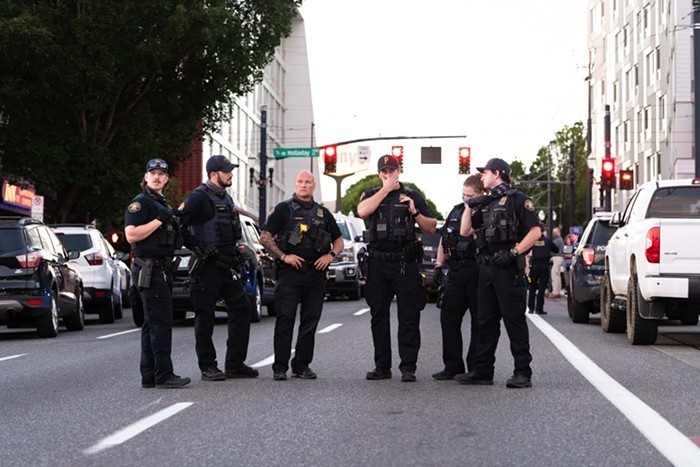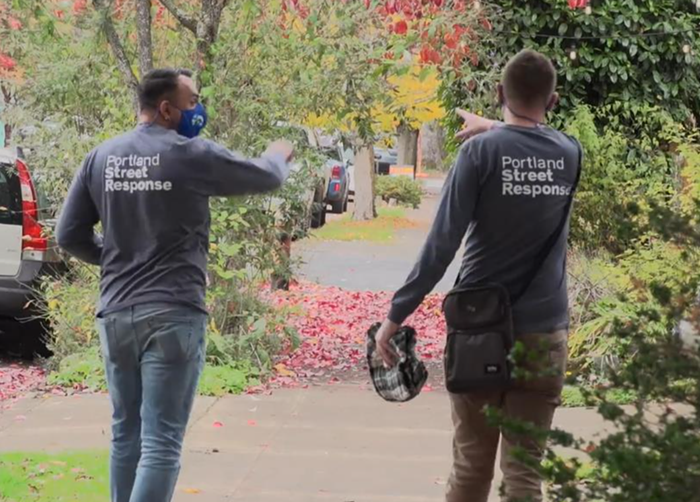AFTER KELLY SWOBODA was killed by Portland police four years ago, news outlets across the country shared the lurid details of his van.
Swoboda, whom local cops confronted in March 2014 after reports that he was acting suspiciously around teenage girls, had outfitted his minivan with chains and ropes. The vehicle contained pornographic movies that emphasized the youth of their actresses. Cops found latex gloves and lubricant.
The New York Daily News—writing of Swoboda’s death in a gunfight with a Portland officer, and his earlier attempted kidnapping of a Milwaukie tanning salon employee—dubbed him a “van sicko.” The facts of the case make it hard to disagree.
But how those facts came to light is now a matter of some controversy—one that has ramifications for more recent officer-involved shootings.
In a report released last week, an independent auditor took the Multnomah County District Attorney’s Office to task for the way it presented the Swoboda case to the grand jurors who decided whether to charge the cop who killed him, Officer John Romero.
Since 2010, the California-based OIR Group has looked into how the Portland Police Bureau (PPB) handles police shootings. In its latest analysis, the organization extends that scrutiny, arguing prosecutors needlessly—and perhaps unethically—brought the disturbing details of the contents of Swoboda’s van before jurors, even though they had little bearing on the reason Romero shot Swoboda.
“The grand jury presentation should have focused on the overwhelming evidence that Officer Romero acted in self-defense when he used deadly force,” OIR’s report found. “Unfortunately, the grand jury proceeding was infected with evidence about Swoboda’s history, character, and presumed intent.”
The Multnomah County District Attorney’s office has disagreed, telling the Mercury (and OIR) that the information it presented to grand jurors “was highly relevant and admissible.”
The debate highlights the influence prosecutors hold when it comes to deciding whether a cop who shoots someone is charged. And it comes as the family of Quanice Hayes, the 17-year-old killed by Portland police in February 2017, has promised a lawsuit against the city, calling the grand jury inquiry into Hayes’ death a farce.
“You have a 17-year-old kid that’s killed by police,” the family’s attorney, Jesse Merrithew, told the Mercury last week. “The only process that’s happened is a grand jury proceeding that—if you look at the transcripts—it’s a joke.”
In Multnomah County, the facts of every officer-involved shooting go before a grand jury, regardless of whether the shooting appears potentially criminal. District Attorney Rod Underhill takes the extraordinary step of releasing the transcripts of grand jury proceedings into fatal police shootings. In most places, the hearings remain secret.
Because of this, Portlanders get rare insight into how prosecutors present cases to grand juries, which don’t receive input from judges or defense attorneys when deciding whether charges are warranted against a potential defendant. The process has often been scrutinized for the sway prosecutors have. As one well-known joke tells it, a prosecutor could convince grand jurors to “indict a ham sandwich."
“The prosecutor has an amazing amount of control over a grand jury,” says Greg Hurley, an analyst with the National Center for State Courts. “They can signal the grand jury in a lot of different ways in terms of the outcome they’re looking for.”
In the case of Swoboda’s death on March 12, 2014, the OIR report suggests prosecutors went above and beyond to ensure there wasn’t an indictment.
On the day of the incident, police were responding to a report of a man leering at teenage girls from his van near Wilson High School in Southwest Portland. Romero eventually came across Swoboda near a van that matched the report’s description, and ordered him to sit down. Swoboda complied, but then pulled out a gun and shot Romero in the hand and arm. Romero returned fire, killing the man.
Details that emerged after the shooting were chilling. Clackamas County authorities believed Swoboda had recently kidnapped a tanning salon employee near Milwaukie, pistol whipping her and binding her hands and feet with duct tape. The woman told authorities she escaped by jumping from Swoboda’s van as he drove.
Cops also found notes on Swoboda’s body suggesting he’d been following girls in multiple cities, writing down where and when he saw them, and rating them on attractiveness.
And then there was the van, with its chains and porn and latex gloves. It became a brief focal point for prosecutors in the grand jury process, transcripts show.
Chief Deputy District Attorney Don Rees, questioning a Clackamas County detective in the hearing, described the van as a “moveable dungeon or torture chamber.” He called forth details of what appeared to be smears of blood in the vehicle, and paved the way for a narrative in which Swoboda was intent on succeeding in his second attempt to abduct a woman.
“As an investigator,” Rees asked the detective, “looking at chains mounted to the floor, ropes, zip ties, teen pornography, padlock, what are you thinking when you see all of this?”
“I’m thinking exactly that one victim got away, and he wasn’t going to let the next one get away,” the detective, Mary Nunn, responded.
It’s possible Nunn was right. But the OIR Group report says the information still had no place in front of a grand jury, because Romero had no idea of Kelly’s history or the contents of his van when the shooting occurred.
“In the grand jury context, there is no judge to evaluate the probative values versus prejudice of evidence elicited by the prosecutor,” reads the report. “Prosecutors themselves serve as the only check with respect to what evidence is presented.”
The report calls prosecutors’ decision to introduce facts of the kidnapping, descriptions of the porn, and other details “extremely prejudicial and of no real additional probative value,” and suggests the evidence might not have been allowed if Romero were being tried in court.
“It was a clear case,” says Michael Gennaco, one of the report’s authors. “The officer got shot just before he returned fire. So what was the reason for bringing in this prejudicial evidence?”
“This isn’t about putting [Swoboda] on trial,” Gennaco adds. “He’s dead.”
Prosecutors stand by their decision. Brian Davidson, one of the attorneys who presented the case to grand jurors, argues that the detail of Swoboda’s earlier crime had bearing on the shooting.
“It’s perfectly reasonable that people can imagine that Mr. Swoboda would imagine police officers are out there looking for him in that van,” Davidson says, suggesting that could make Swoboda more likely to attack. “The reason that’s germane is to determine whether the officer’s use of force against Mr. Swoboda was justified or not.”
Davidson also argues the information would have been admitted by a judge in an open court setting.
The OIR report’s findings come at an interesting time. The family of 17-year-old Hayes is making very similar arguments.
Merrithew, the family’s attorney, says that prosecutors used a similar strategy in investigating Hayes’ February 9, 2017 death that they did with Swoboda—namely, that in presenting evidence before the grand jury, they included facts that the cop who shot Hayes, Andrew Hearst, didn’t know at the time of the shooting.
On the morning Hayes was killed, police and witnesses have said the teen used drugs and robbed a man using a fake gun, among other things. Cops responding to a call were aware that Hayes could be armed, but none testified to seeing a fake gun on him before Hearst shot him three times (a fake gun was found near his body).
“From a legal perspective, the issue of the reasonableness of Officer Hearst’s use of force depends entirely on what he knew at the time that he used force,” Merrithew argues. “The grand jury got to learn all sorts of things about Quanice that Officer Hearst did not know. The grand jury is being misled from the start about what Hearst knew and when he knew it.”
Prosecutors undoubtedly disagree, but in Hayes’ case there’s a chance a court will decide. The family plans to file suit against the City of Portland and Hearst in coming weeks.


















